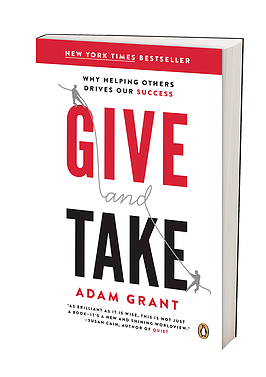By Logan McCune
A few years ago the CEO of the company I was working for asked all the company directors to read “Give and Take.” The book, by organizational psychologist Adam Grant, asserts there are three types of behaviors in terms of how we interact with others: giving, taking and matching. My CEO hoped that we—the management team—would apply an outward ‘giving’ approach to our employees and clients, rather than the more inward-focused, scarcity approach that is prevalent in many organizations. I loved the book, and the concepts made perfect sense to me.
The Givers, the Takers, and The Matchers

Adam Grant’s detailed research shows that we each tend to be dominant (but not limited) to giving, taking or matching behaviors. And contrary to popular belief, Grant provides evidence that giving— strategic giving, specifically—is the best way to succeed in business and life.
Through examples and studies he’s completed, Grant shows that the majority of us tend to be matchers in life; “you scratch my back and I’ll scratch yours” tends to be how most of us operate. But at the very top of nearly every field, the most successful people are strategic givers who, because they put the needs of their teams and clients first, have built solid reputations and strong long-term relationships with people who matter in their careers and lives. They give without expecting anything in return, giving generously of their time, resources, knowledge, contacts, and experience.
[Adam] Grant provides evidence that giving— strategic giving, specifically—is the best way to succeed in business and life.
It really struck a chord with me, and I could relate with all three types. I know people in my life, for example, who are takers, and I know how that’s limited them; they rise to only a certain level of success before their behavior and/or reputation limits them further. The degree of success takers are able to inspire and marshal in others is limited as well. And I know matchers, too, who give with the expectation that they will receive something in return. But then there is the final group, the givers of all types. These include ‘overgivers’ who say yes a little too often and get spread too thin and struggle to advance in their careers. But it’s strategic givers, those that genuinely care about the bigger picture while being careful with who they give their time, talents, and resources to, that rise to the top while engendering success in others. These individuals are cautious in how they provide support to takers and matchers so as not to be spread too thin, while being quick to give to other givers knowing these like-minded folks will turn around and share the same resources with others.
How Give & Take Helps: Cultivating Awareness and Courage
In addition to being able to apply these types to people, the book has prompted me to analyze myself as well. I relate most to the dominant giver type, and since reading the book, I’ve been conscious of the need to become a little more wary of the takers and a little more strategic in terms of how I give. Adam Grant talks, for example, about givers who tend to fizzle out in their ability to lead change or enact successes for themselves and others because they tend not to have the courage to speak up and be a strong communicator who can influence and persuade others. I’ve seen that in others, and recognize the importance of that kind of courage when it comes to giving. That’s so important to cultivate in people within an organization.
How Strategic Giving Helps Coachees and Coaches, Too
In my role as Manager, Culture & People, I work a lot with Rulesware’s coaching program and I can see, in some of the coaches I work with, that they’re natural givers at heart who may not have quite the level of courage that they could have. I suspect, too, that when it comes to planning meetings or group meetings they tend to be a bit more quiet than they could be. Whether that’s a lack of confidence or natural introversion, I’m not sure, but I do hope that I’m going to be able to influence and persuade them that their opinion is just as important as others in the room, that their ideas are just as good as everyone else’s … and to generally communicate in a stronger way. If they’re in a meeting, for example, and the takers and the matchers are more vocal, those givers need to flex their courage and not be ploughed over by the rest of the room.
Companies as a whole tend—much like people—to embrace (whether by accident or design) being takers, matchers, or givers in their approach to business. You can see it in their DNA, their culture, and their leadership style.
Another danger of being a giver in an organization, without being strategic about it, is being spread too thin and saying yes to everything rather than choosing more strategically what to say yes to. I enjoy being able to offer that insight, and to truly encourage them to develop the courage to speak up. I think this is hugely valuable for anyone who’s a coach or manager.
Applying the Give & Take Model to Companies
The ideas in the book have guided me in other ways as well; it really did influence my decision to join Rulesware, for example.
I think that companies as a whole tend—much like people—to embrace being takers, matchers, or givers in their approach to business, whether that’s by accident or design. You can see it in their DNA, their culture, and their leadership style.
As I researched Rulesware on its website, on Glassdoor, and on its social channels, I got a sense of its outward focus on its people and culture, especially the clients. I liked that Rulesware is willing to walk away from bad business and to tell clients what’s truly required. And now, being here, I like seeing that we really do go to great lengths to do what’s right by the client and by our employees. Not all organizations do that; I know of many that will do anything to get the deal, and then do subpar work, or mistreat their employees. In all ways, I’m finding that Rulesware very much falls into the ‘strategic giver’ camp at the organizational level.
As I reasearched Rulesware…I liked that Rulesware is willing to walk away from bad business and to tell clients what’s truly required.
How Job Seekers Can Use Give and Take: Know the Takers, Matchers and Genuine Givers
I’d certainly recommend that job seekers could benefit from this book, as well, simply by providing a framework for assessing the companies you’re looking to work with.
As a job seeker, for example, you might ask yourself: are there clues that indicate whether the company is a ‘taker’-type organization that sees you as a resource, or a means to an end without giving anything back? Or is that company, at the organizational level, more of a matcher, rewarding your contributions with things like professional development, resources or leadership? Best, still, is the company one of those rare organizations that puts you as a person and employee first, that puts company culture first, and that doesn’t make decisions based just on the bottom line but rather on behalf of its employees and clients?
I’d say those are the companies you’ll want to align yourself with. Those are the rare companies that will continue to value you and help you achieve your goals.
Logan McCune is Rulesware’s Manager, Culture & People. Prior to joining Rulesware, Logan worked with Buildingi, a technology consulting company, where he managed HR from the company’s Seattle and Costa Rica offices. When he isn’t working, Logan loves to spend time with his wife Shayla and their two kids, Ansley and Micah, aged six and three.
Find out more about Rulesware’s coaching program here—or better yet, get in touch with us to find out what kind of a company we really are. We’re hiring!



